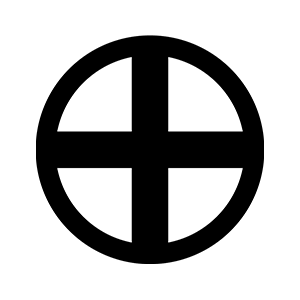Satsuma Domain (1/2)A leading figure of the Meiji Restoration

Shimazu family crest: “Circle and 10”
- Article category
- History of the domain
- domain name
- Satsuma Domain (1601-1871)
- Affiliation
- Kagoshima prefecture
- Related castles, temples and shrines

Kagoshima Castle

Kokubu Castle
- related castles
The Satsuma domain was ruled by the Shimazu clan throughout the Edo period.
The Shimazu clan is a clan that has continued to fight to control all of Kyushu ever since its founder, Tadahisa Shimazu, was appointed the head of Shimazu Manor by Minamoto no Yoritomo during the Kamakura period.
Under the Toyotomi administration, he conquered almost all of Kyushu, except for a few areas, and rose to become the daimyō with the fifth highest number of stones in the country, following the Tokugawa, Uesugi, and Maeda clans.
It was also a domain that played a leading role in the Meiji Restoration at the end of the Edo period. Let's unravel the history of the Satsuma domain.
Shimazu clan before the Edo period
The Shimazu clan is a family whose ancestor was Tadahisa Shimazu, who was appointed head of Shimazu Manor by Minamoto no Yoritomo during the Kamakura period.
During the period of the Northern and Southern Courts, they participated in Emperor Go-Daigo's movement to overthrow the Kamakura shogunate, and as families with the same clan fought each other over the headship of the family, they expanded their influence throughout Kyushu.
I will not go into the history of the Shimazu clan's conquest of Kyushu, but in the Sengoku period, they controlled all of Kyushu except for parts of the former and Bungo provinces.
Eventually, Toyotomi Hideyoshi took control of the country and the pacification of Kyushu began, but as a result of the mediation and negotiations between the various feudal lords, the Shimazu clan fought against Toyotomi Hideyoshi, and as a result, their main territories of Satsuma, Osumi, and Hyuga prefectures were conquered. All territories will be relieved.
He achieved remarkable military feats in the Korean War, and eventually rose to become a great daimyo with a wealth of 610,000 koku, second only to the Maeda clan's 810,000 koku.
Later, in the Battle of Sekigahara that broke out in 1600, the 17th head of the family, Yoshihiro Shimazu, sided with the Western army, but the 16th head of the Shimazu family, Yoshihisa Shimazu, who was the chief executive of the Shimazu family, fought with Tokugawa Ieyasu. After years of post-war negotiations, we were able to obtain relief for all territories.
In this way, the Shimazu clan was incorporated into the Shogunate system as the ``Satsuma Domain'' following Tokugawa Ieyasu.
Differences between the political systems of the Satsuma domain and other domains
The Satsuma domain was ruled by the Shimazu clan from the time it was founded until the Meiji Restoration, and its political system is slightly different from other domains.
In 1609, Tadatsune Shimazu, the first lord of the Satsuma domain, led an army of 3,000 troops to Ryukyu, occupied it, and made it a vassal state.
As a result, the Amami Islands were ceded to the Ryukyus in 1613. The Satsuma domain established a magistrate and a magistrate's office, making it a territory under its direct control.
It is also said that Tadatsune Shimazu was the first to declare to the Edo shogunate that he would keep his wife and children in the Edo domain residence, pioneering the sankin kotai movement.
In addition, the Satsuma domain, including Ryukyu, had the highest stone value of 900,000 koku, second only to the Kaga domain.
For this reason, Kagoshima Castle, which became the domain office to show obedience to the shogunate, did not have a castle tower and is said to have had defensive problems.
Instead, they left medieval-style mountain castles in various places and created a unique system called the outer castle system, in which 113 sections were each guarded by vassals.
In addition, the ruling system from the early modern period remains, and in addition to the castle system, there was a system called ``monwari,'' in which farmers were divided into groups called ``kado,'' and each group owned land. I was there.
Furthermore, since much of the territory of the Satsuma domain was on the Shirasu Plateau, which was unsuitable for rice cultivation, the official koku height was 770,000 koku, but the actual koku height was 350,000 koku, which was at the time the domain was established. Since then, there have been some financial difficulties.
Furthermore, because the shogunate had a policy of weakening powerful domains, the Satsuma domain was frequently assigned large-scale assistance and construction projects.
In particular, the Kiso Sankawa renovation work (Horeki flood control) that was assigned in 1753 was a huge expense, and the person in charge of the work, Satsuma feudal chief retainer Tsunei Hirata, assumed responsibility after the work was completed. There have also been some tragedies where people have committed suicide by stealing it.
In this way, we can see that although the relationship between the Satsuma domain and the shogunate appeared to be calm and friendly at first glance, there were intense negotiations and complex emotions swirling beneath the surface.
Satsuma domain until the end of the Edo period
The Satsuma clan is best known for Nariaki Shimazu, a leading figure in the Meiji Restoration, but the Satsuma clan's strong interest in European culture was shared by Shigego Shimazu, the 8th feudal lord.
Since the first feudal lord, Tadatsune Shimazu, the shogunate and the Satsuma domain have often had marriage agreements, and the eighth lord, Shigego Shimazu, was also the father of Kodaiin, the lawful wife of the 11th shogun, Ienari Tokugawa.
For this reason, he was not strongly criticized for his strong interest in academics and European culture, and was able to make a name for himself as a ``random daimyo'' and a ``scholar daimyo.''
In fact, he personally visited the Dutch trading post in Nagasaki and boarded a Dutch ship.
In 1771, Shigego Shimazu established Enbukan as a domain school, Zoshikan, and martial arts practice hall, and worked to spread education. In addition, in 1773, he established Meijikan (astronomical museum) and began research on calendars and astronomy.
In 1774, he even established a medical school and worked hard to train medical technology.
These schools were open to farmers and townspeople with permission, and this open door served as a breeding ground for great figures who were active at the end of the Edo period, including Takamori Saigo. .
Furthermore, Shigego Shimazu lived to be 89 years old, which was a long life for those days, and he also lived with his great-grandson, Nariaki Shimazu, for a period of time.
Although he liked a luxurious life, in his later years he made important use of Chosho Hirosato, a former lower-class samurai, and worked on the Tenpo Reforms of the Satsuma Domain in order to resolve financial difficulties.
Incidentally, the German physician and naturalist Siebold also had an audience with Shigego Shimazu in his later years, and left behind a record that he was ``an enlightened and intelligent ruler.''
Meiji Restoration and Satsuma Domain
The most well-known lord of the Satsuma domain is Nariaki Shimazu, the 11th lord. He was the great-grandson of Shimazu Shigego, the 8th feudal lord, and was loved for his cleverness.
- related castles

- WriterAYAME(Writer)I am a writer who loves history, focusing on the Edo period. My hobbies are visiting historical sites, temples and shrines, and reading historical novels. If there is a place you are interested in, you can fly anywhere. I'm secretly happy that the number of sword exhibitions has increased recently thanks to the success of Touken Ranbu.




